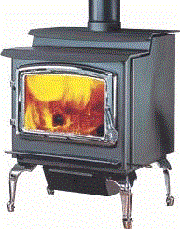A wind turbine, which is installed on top of a tall tower, collects
kinetic energy from the
wind and converts it to electricity that is compatible with a home's electrical system.
Small Scale Grid Connected Hybrid Wind System
In a normal residential hybrid / wind turbine application, a home is served simultaneously
by the wind turbine and alocal utility. If the wind speeds are below cut-in speed (7-10 mph)
there will be no output fromthe turbine and all of the needed power is purchased from the utility.
As wind speeds increase, turbine output increases and the amount of power purchased from
the utility is proportionately decreased. When the turbine produces more power than the
houseneeds, the extra electricity is sold tothe utility. All of this is done automatically.
There are no batteries in a modern residential hybrid / wind turbine system.
Small Scale Off Grid Wind System
Small wind systems for remote applications operate somewhat differently.
Most small turbines have very few moving parts and do not require any regular maintenance.
They are designed for a long life (up to 20 years) and operate completely automatically.
Typical off grid wind turbine system diagram:

Off Grid Wind Turbine Systems Include:
1. Wind turbine: which is installed on top of a tall tower, collects kinetic energy from the wind
and converts it to electricity that is compatible with a homes electrical system.
2. Wind controller:
3. Battery bank: can be a single battery or multiple batteries connected together to create essentially one large battery of the required voltage and amp-hour capacity. In some ways
the battery configuration and capacity are the most important electrical power decision to
make, and a wise choice can help guarantee a steady supply of electrical power
as well as a system that is simple to operate and maintain.
4. Inverter: A power converter that "inverts" the DC power from the panels into AC power.
The characteristics of the output signal should match the voltage, frequency and power
quality limits in the supply network.
5. Loads: Stands for the network connected appliances in the building that are fed from
the inverter (AC loads), or from the battery bank (DC loads).
wind and converts it to electricity that is compatible with a home's electrical system.
Small Scale Grid Connected Hybrid Wind System
In a normal residential hybrid / wind turbine application, a home is served simultaneously
by the wind turbine and alocal utility. If the wind speeds are below cut-in speed (7-10 mph)
there will be no output fromthe turbine and all of the needed power is purchased from the utility.
As wind speeds increase, turbine output increases and the amount of power purchased from
the utility is proportionately decreased. When the turbine produces more power than the
houseneeds, the extra electricity is sold tothe utility. All of this is done automatically.
There are no batteries in a modern residential hybrid / wind turbine system.
Small Scale Off Grid Wind System
Small wind systems for remote applications operate somewhat differently.
Most small turbines have very few moving parts and do not require any regular maintenance.
They are designed for a long life (up to 20 years) and operate completely automatically.
Typical off grid wind turbine system diagram:

Off Grid Wind Turbine Systems Include:
1. Wind turbine: which is installed on top of a tall tower, collects kinetic energy from the wind
and converts it to electricity that is compatible with a homes electrical system.
2. Wind controller:
3. Battery bank: can be a single battery or multiple batteries connected together to create essentially one large battery of the required voltage and amp-hour capacity. In some ways
the battery configuration and capacity are the most important electrical power decision to
make, and a wise choice can help guarantee a steady supply of electrical power
as well as a system that is simple to operate and maintain.
4. Inverter: A power converter that "inverts" the DC power from the panels into AC power.
The characteristics of the output signal should match the voltage, frequency and power
quality limits in the supply network.
5. Loads: Stands for the network connected appliances in the building that are fed from
the inverter (AC loads), or from the battery bank (DC loads).
No Utility Bills Inc.
All rights reserved.
Last modified: 04/18/15


